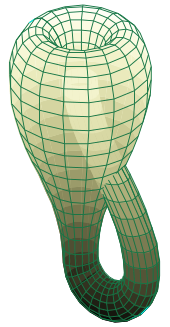
Back Klein-bottel Afrikaans زجاجة كلاين Arabic Kleyn şüşəsi Azerbaijani Бутилка на Клайн Bulgarian Ampolla de Klein Catalan Kleinova láhev Czech Kleinflaske Danish Kleinsche Flasche German Φιάλη του Κλάιν Greek Botelo de Klein Esperanto

In mathematics, the Klein bottle (/ˈklaɪn/) is an example of a non-orientable surface; that is, informally, a one-sided surface which, if traveled upon, could be followed back to the point of origin while flipping the traveler upside down. More formally, the Klein bottle is a two-dimensional manifold on which one cannot define a normal vector at each point that varies continuously over the whole manifold. Other related non-orientable surfaces include the Möbius strip and the real projective plane. While a Möbius strip is a surface with a boundary, a Klein bottle has no boundary. For comparison, a sphere is an orientable surface with no boundary.
The Klein bottle was first described in 1882 by the mathematician Felix Klein.[1]
- ^ Stillwell 1993, p. 65, 1.2.3 The Klein Bottle.
© MMXXIII Rich X Search. We shall prevail. All rights reserved. Rich X Search